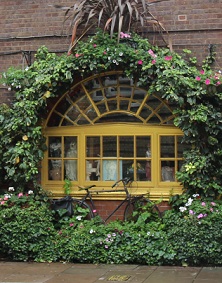
Whilst it is possible to design a vertical garden to minimise maintenance requirements, there will always be some things which need ongoing attention.
The Nature of Plants
Like all living things, plants grow. Not only do they grow above ground, but their roots grow below ground too. Even when a plant reaches its maximum size, it continues to grow in that it bears fruit and flowers, new shoots will replace old ones and, with regards to trees, shrubs and climbers, the girth of the main trunk and stems continues to widen. Deciduous plants grow new leaves each spring and then defoliate in the autumn. This continuous cycle of growing brings about some maintenance requirements in order to preserve a vertical garden.
Things to Consider
- Higher plants are less visible. The deterioration of plant health can go unnoticed more easily if plants are very high up on a green wall out of sight.
- Plants in the middle of walls or at the top may be less accessible and therefore more difficult to maintain.
- The roots of some vigorously growing plants may escape their containers or substrates and penetrate the surface of walls if they are not suitably sealed or strong.
- Some types of climbing plants may have suckers which absorb moisture from wall materials or cause damage by getting behind the surface. These plants may best be avoided if they cannot be kept away from direct contact with the wall.
- Climbing plants used on green façades will make it difficult to maintain the walls behind them.
- Green walls are a more intensive method of growing plants since many plants are grown side-by-side in a small area. This leads to greater maintenance needs.
Maintenance of Hanging Baskets
Conditions for a plant are different in a basket. You need to understand these differences and compensate.
- The baskets may be exposed to strong winds which can cause wind scorch to leaves and may dry out the soil mix relatively quickly. Therefore, sheltered positions are best for baskets where possible.
- Baskets are often hung under eaves where they do not get watered when it rains. It is advisable to water baskets regularly and add water crystals to the soil mix, or apply a wetting agent. Using plastic lining at least around the base of the basket will help to retain moisture for longer. Baskets which are difficult to access with a watering can may be watered with a hose that will reach them. Another option is to use a watering lance extension attached to either a sprayer or a hose.
- Baskets are also often hung where they don’t get much sunlight e.g. under a veranda. In these instances it is wise to choose shade-tolerant plants or move the basket to a sunnier location.
- Baskets are shallower than most other containers so the plants have a restricted root ball. Therefore, choose plants that don’t have overly-vigorous root systems and give plenty of water and liquid feeds throughout the growing season to keep the plants in good health. Many people use baskets to provide seasonal colour to a green wall rather than permanent plantings.
- Replant the basket as soon as the plants start to die off rather than leaving them to gradually diminish.